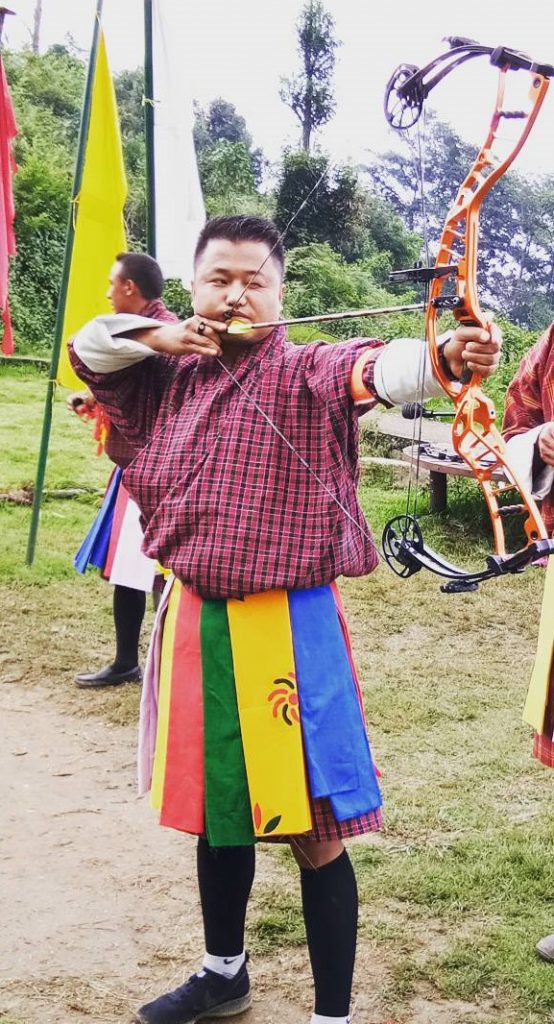
National Flag
The National Flag of Bhutan is divided diagonally into two equal halves with a dragon along the diagonal line. The upper half of the flag is yellow representing the secular power and authority of the king, while the lower half is saffron-orange symbolising the practice of the Buddhist religion. The dragon is white signifying the sovereignty and the identity of our kingdom, while the wish fulfilling jewels in its claws stand for prosperity and wealth.

National Emblem
The National Emblem of Bhutan is contained in a circle, composed of double-diamond thunderbolt (Dorje) placed on top of a lotus surmounted by a jewel and surrounded by a male and female dragon on either side. The diamond thunderbolt represents the harmony between the secular and religious power that exists within the country, the lotus symbolises purity, the jewel sovereignty and the dragons with their thunderous roar the identity and name of our country ‘Druk-Yul’.

National Sport
The national sport of Bhutan is slightly different version of Archery. Traditional bows and arrows made out of bamboos are used to shoot relatively small targets that is 3 feet tall and 11 inches wifde, which are placed about 145 metres (476 feet) apart. The sport consists of two teams with 13 players each, who take turns to shoot two arrows at a time towards the opposing team’s target. What makes archery different in Bhutan is, that opposing teams stay near the targets as a measure to distract their opponents, often making the sport dangerous. Women also partake in the event, with their sole purpose being to distract the opposing team either by dancing or teasing. With access to the outside world, players have now started replacing traditional bamboo bows with modern compound bows. Archery is played during most of the festivals and events in Bhutan. It was declared as the national sport in 1971 when Bhutan became a member of the United Nations.

National Animal
The national animal of Bhutan is Takin (Burdorcas Taxicolor). It is a very rare herbivore animal that is found in altitudes above 4000m. According to bhutanese mythology, the Takin was a result of a miracle performed by the folk hero and saint, Drukpa Kuenley (also known as the Divine Madman), when he took a heap of cow and goat bones and reassembled them into a new animal and brought it to life.

National Bird
The national bird of Bhutan is the Raven (Corvus Corax Tibetanus). It is revered as a representation of one of the most powerful deities of Bhutan, Jarog Donghen. Jarog Dongchen along with Yeshey Gonpo (Mahakala) and Palden Lhamo (Mahakali) form the Divine Trinity, that protects the King and the people from harm and safeguards their wellbeing. Even the Dragon Kings of Bhutan adorn The Royal Raven Crown to signify the faith and importance of these birds. According to Bhutanese mythology, it was believed that Yeshey Gonpo, one of the divine trinity, took the form of a Raven to guide Zhabdrung Ngawang Namgyel to Bhutan, who later became the first person to unify Bhutan in the 17th Century.

National Tree
The national tree of Bhutan is the Cypress (Cupressus Torolusa). The tree is considered as a sacred tree and its ability to survive in harsh terrains is believed to symbolise the perseverance, simplicity, braveness and the overall nature of the Bhutanese people. These trees are often planted near monasteries, schools, dzongs and religious places, whereby the leaves, twigs, and branches of the tree are used as incense during various important and religious events. The trees are generally found at altitudes that range between 1800 – 3500 metres.

National Flower
The national flower of Bhutan is the Blue Poppy (Mecanopsis Gakyidiana). These flowers were considered to exist only in myths as its existence was not confirmed in the earlier times, however, today, these flowers can be found along the high mountain passes of the country. The Blue Poppy of Bhutan is a new species of the poppy plant and is one to the rarest flowers in the world characterised by blue flowers with shades of violet, with a furry texture. These flowers are very difficult to grow and hence can only be spotted in their full vigour atop high mountains.